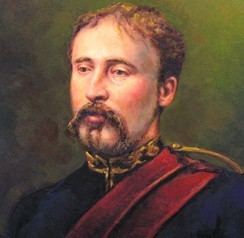Years of service 1852–1868 Parents John Henry Dunn | Role Armed force officer Allegiance United Kingdom Name Alexander Dunn | |
 | ||
Born 15 September 1833York, Upper Canada, Canada ( 1833-09-15 ) Unit 11th Hussars100th Regiment of Foot Died January 25, 1868, Senafe, Eritrea Similar People James Brudenell - 7th Earl o, Francois Certain Canrobert, FitzRoy Somerset - 1st Baron, Arthur Poulter, Henry Tandey | ||
Alexander Roberts Dunn VC (15 September 1833 – 25 January 1868) was the first Canadian awarded the Victoria Cross, the highest and most prestigious award for gallantry in the face of the enemy that can be awarded to British and Commonwealth forces.
He was born in York (later Toronto) in 1833, the son of John Henry Dunn, and studied at Upper Canada College and at Harrow School, England. He purchased a commission in the Hussars in 1852.
Dunn was awarded the Victoria Cross for his actions at the Charge of the Light Brigade during the Battle of Balaclava on 25 October 1854 when he was 21 years of age and serving in the British Army's 11th Hussars. Dunn rescued a sergeant by cutting down two or three Russian lancers who had attacked from the rear. Later in the battle he killed another Russian who had been attacking a private.
He sold his commission at the end of the Crimean War but rejoined the Army in 1858 as a major in the 100th Regiment of Foot. He exchanged into the 33rd Regiment of Foot, in 1864 in which regiment he remained until his death in the Abyssinian War.
Dunn was promoted to the rank of colonel in 1864 and commanded the 33rd Regiment at the start of the 1868 Expedition to Abyssinia, but was killed in unusual circumstances during a hunting accident at Senafe before the military part of the campaign started. He was the first Canadian to command a British Army regiment.
His grave (in present-day Eritrea) had been neglected for many years. It was discovered after over a hundred years by Canadian Army Forces for the United Nations Mission to Ethiopia and Eritrea (UNMEE) during their mission as peacekeeping force to the Eritrea-Ethiopia war of 1998-2000. The discovery as narrated by Ben Mitchell of the Canadian Armed Forces is:
We had just advanced from our rear camp in Dekemhare into Senafe. We had crossed both trench lines in Senafe and their mine fields. Tensions were very high for not only the Eritrea and Ethiopian armies but for us as well. There was still military forces in the area, whom were not supposed to be there. We knew our task of getting the militaries to withdraw would be tuff. We set up camp in the school yard at the base of that amazing cliff. My Lieutenant and I left the camp right away to search for a well in the city and this is when it first happened. The children in the city gathered around us and said "Canada" while pulling our hands to lead us somewhere. Now there was no way we were going anywhere with these kids. This thing smelled of an ambush badly. How did they know the word "Canada" and why were they so eager to lead us away? The two of us then returned to the schoolyard and reported this unusual event to Headquarters (HQ). 2 weeks went by and each patrol that entered the city had the same experience with the kids. Each time they would report it to HQ and say they did not follow the children. Finally HQ got tired of hearing about these children and orders us to investigate. Now this is when it gets embarrassing for us. We geared up to follow these kids like we were entering an ambush...we were ready for anything that may happen. We had over 300 rounds of ammunition per soldier, flak jackets, radios, machine guns. We were not going to be caught off guard. When we entered the city, the same routine happened with the kids, but this time we let them lead us. Weapons on our shoulders we walked through the city slowly waiting for something to happen. I remember how hot it was that day and how much I was sweating. Finally we got to a cemetery on the outskirts of the city and the kids started pointing at this tombstone. We looked at the name "COL DUNN". When we got back to camp we radioed in what had happened. HQ sent a report back to Canada asking them to figure out who this DUNN was. A week later we found out. The kids had led us to the grave of a Canadian war hero R. Dunn, one of the first winners of the Victoria Cross. The highest order of merit issues in the Canadian Forces. This man was a legend. He had gone on safari Africa in 1860's and never returned. He was a Canadian hero who had been lost for over a hundred years. These kids whom we thought were leading us into an ambush had done Canada a great service and located Colonel R. Dunn Victoria Cross. If those kids were not as persistent as they were we would never have followed them and we would have never found Colonel Dunn.
His grave after the discovery was repaired in 2001 by a group of Canadian Forces engineers from CFB Gagetown.
For over 50 years his medals were on display in the main foyer of his old school, Upper Canada College, in Toronto. In 1977, due to a number of recent thefts and "losses" of Victoria Cross medals the school replaced the VC with a copy and moved the original to their bank safe deposit box.
A memorial, Alexander Dunn Park, located on Bellrock Drive, dedicated to Colonel Alexander Roberts Dunn, V.C., was erected in Ottawa, Ontario assisted by Royal Canadian Legion Branch 638 (Kanata).
